If you’ve ever had a drink or two, you might have wondered how long alcohol stays in your system.
Does it disappear as soon as you stop feeling tipsy? Or does it linger for hours or even days? What factors affect how your body processes alcohol? And how can you measure the amount of alcohol in your body?
Maybe you’re curious about how it affects your health, or maybe you’re worried about passing a drug test.
Whatever the reason, it’s important to understand how alcohol is measured and metabolized in your body and what factors can influence how long it takes to clear out.
What is a Standard Drink?
Before we answer how fast alcohol is processed in your body, let’s first define standard drinks.
According to the National Institute on Alcohol Abuse and Alcoholism (NIAAA), one standard drink contains about 14 grams of pure alcohol, which is equivalent to:
- Twelve ounces of regular beer with 5% alcohol content.
- Five ounces of wine with 12% alcohol content.
- 1.5 ounces of distilled spirits (such as vodka, whiskey, gin, etc.) with 40% alcohol content.
Of course, not all drinks are the same size or have the same alcohol content, so you need to be aware of how much alcohol you are actually consuming. For example, a pint of beer (16 ounces) is more than one standard drink, and a martini (2.5 ounces) is almost two standard drinks.
How is Alcohol Metabolized in the Body?
Provided that alcohol is not consumed so quickly as to cause alcohol poisoning, the human body is actually very efficient at processing alcohol.

More than 90% of alcohol intake is metabolized and absorbed in the liver, while the rest is expelled from the body through sweat, urine, vomit, and feces. The entire alcohol metabolism process can be broken down into the steps below:
- Absorption. When alcohol enters the body, it is rapidly absorbed into the bloodstream through the stomach and small intestine walls. This is why you may start feeling the effects of alcohol relatively quickly.
- Distribution. Once in the bloodstream, alcohol is carried throughout the body, reaching various organs and tissues. This widespread distribution contributes to the overall effects of alcohol on the body. It affects different organs in different ways, depending on how much and how fast we drink it.
- Metabolism. The liver is the main organ that breaks down alcohol. It produces an enzyme called alcohol dehydrogenase (ADH), which begins the breakdown of alcohol. ADH converts alcohol into acetaldehyde, a toxic substance.
- Acetaldehyde Conversion. Once alcohol is changed into acetaldehyde, another enzyme called aldehyde dehydrogenase (ALDH) comes into play. ALDH breaks down acetaldehyde into acetic acid, which is a less toxic substance.
Elimination. The final step involves converting acetic acid into carbon dioxide and water, which can be easily eliminated from the body through breath, urine, and sweat. This elimination process occurs primarily in the liver and kidneys.
Keep in mind that the liver can only process a certain amount of alcohol per hour, depending on your body weight, gender, age, and genetics. If you drink more alcohol than your liver can handle, the excess alcohol will accumulate in your bloodstream and cause intoxication.
How Long Does Alcohol Stay in the Body?
The amount of time alcohol stays in your system depends on several factors, such as how much you drink, how fast you drink, what you eat before and after drinking, and your body weight and metabolism.
However, a general rule of thumb is that your body takes about one hour to eliminate one standard drink.
However, a general rule of thumb is that your body takes about one hour to eliminate one standard drink.
Alcohol can still impair your judgment, coordination, reaction time, and memory for several hours after drinking.
Here are some approximate time frames for how long different tests can detect alcohol:
- A breath test or breathalyzer can detect recent alcohol use on your breath for up to 24 hours after drinking.
- A urine test has a relatively short detection window of up to 12 to 24 hours, but some advanced methods like ethyl glucuronide (EtG) tests can detect alcohol byproducts for up to 72 hours or even longer.
- Saliva tests can detect the presence of alcohol in your saliva for up to 24 hours after drinking.
- A hair test measures the presence of alcohol or alcohol byproducts in your hair follicles. Alcohol can be detected in your hair for up to 90 days after consumption.
- Alcohol can be detected in your blood for up to 6 hours after drinking and can be tested using a blood test.
As you can see, alcohol can stay in your body for quite a long time after you stop drinking. This means you could still test positive for alcohol even if you don’t feel drunk or hungover anymore. This could seriously affect your health, safety, and legal status.
For example, if you drive while having alcohol in your system, you could get arrested for driving under the influence (DUI) or cause an accident that could harm yourself or others.
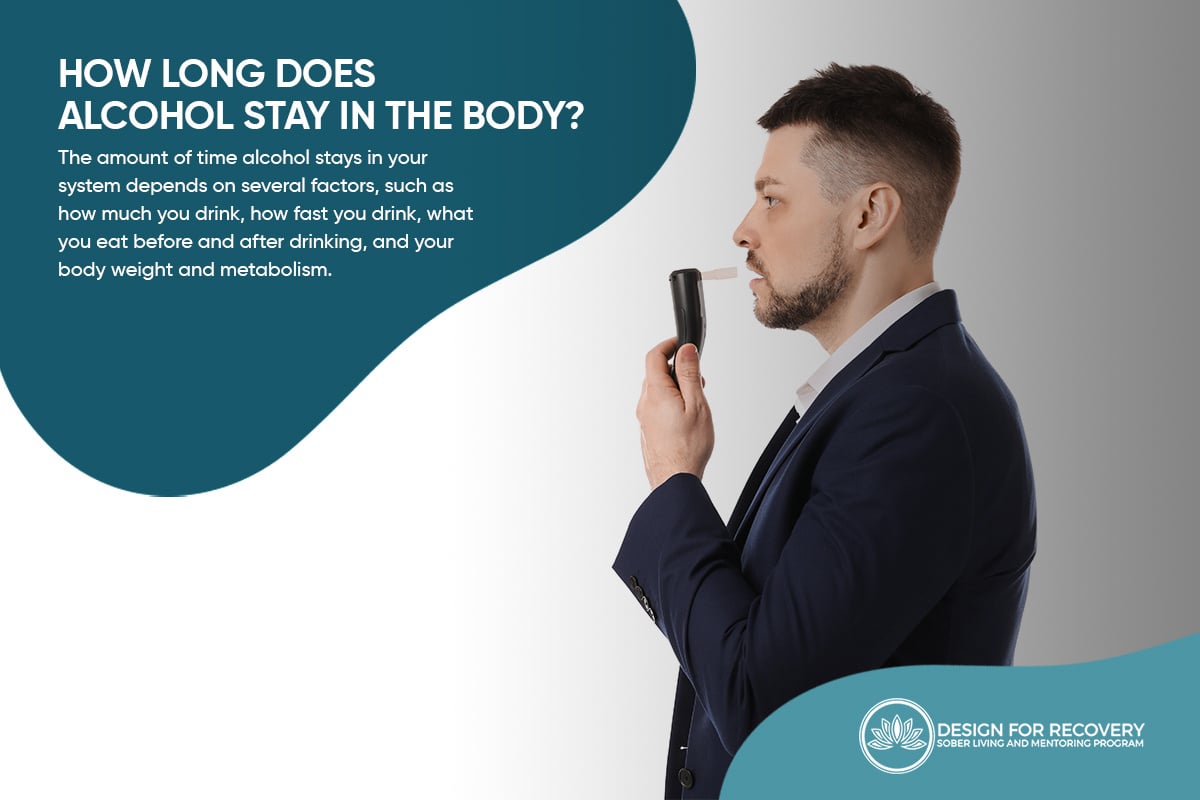
How is Alcohol Measured in Your Body?
Alcohol is typically measured in your body by analyzing your blood alcohol content or blood alcohol concentration (BAC). BAC represents the amount of alcohol in your bloodstream and is usually expressed as a percentage.
Alcohol is typically measured in your body by analyzing your blood alcohol content or blood alcohol concentration (BAC). BAC represents the amount of alcohol in your bloodstream and is usually expressed as a percentage.
For example, a blood alcohol concentration of 0.08% means there are 0.08 grams of alcohol in every 100 milliliters of blood.
It is commonly used in assessing impairment levels and detecting whether a person has ingested alcohol within a certain period. The legal limit for driving in most countries is 0.05% or 0.08%.
The most accurate and reliable way to measure BAC is by a blood test, but it takes longer and requires a medical facility.
Breath tests are commonly used by law enforcement to check for impaired driving, but they can be affected by factors such as mouthwash, medication, or food.
Breath tests are commonly used by law enforcement to check for impaired driving, but they can be affected by factors such as mouthwash, medication, or food.
Meanwhile, urine tests such as ethyl glucuronide (EtG) tests can detect recent alcohol consumption from a urine sample for up to 12 to 24 hours after drinking, but they can also be influenced by hydration levels and kidney function because they can only be used to test BAC after it has been metabolized by the liver.
The longest alcohol can be detected is from hair samples. Hair tests can detect alcohol for up to 90 days after drinking, but they are often expensive and not widely available.
What Impacts How Long Alcohol Stays in Your System?
The main factor that determines how long alcohol remains in your system is how fast your body can break it down and eliminate it. However, the body’s ability to process alcohol can vary depending on several factors, such as:
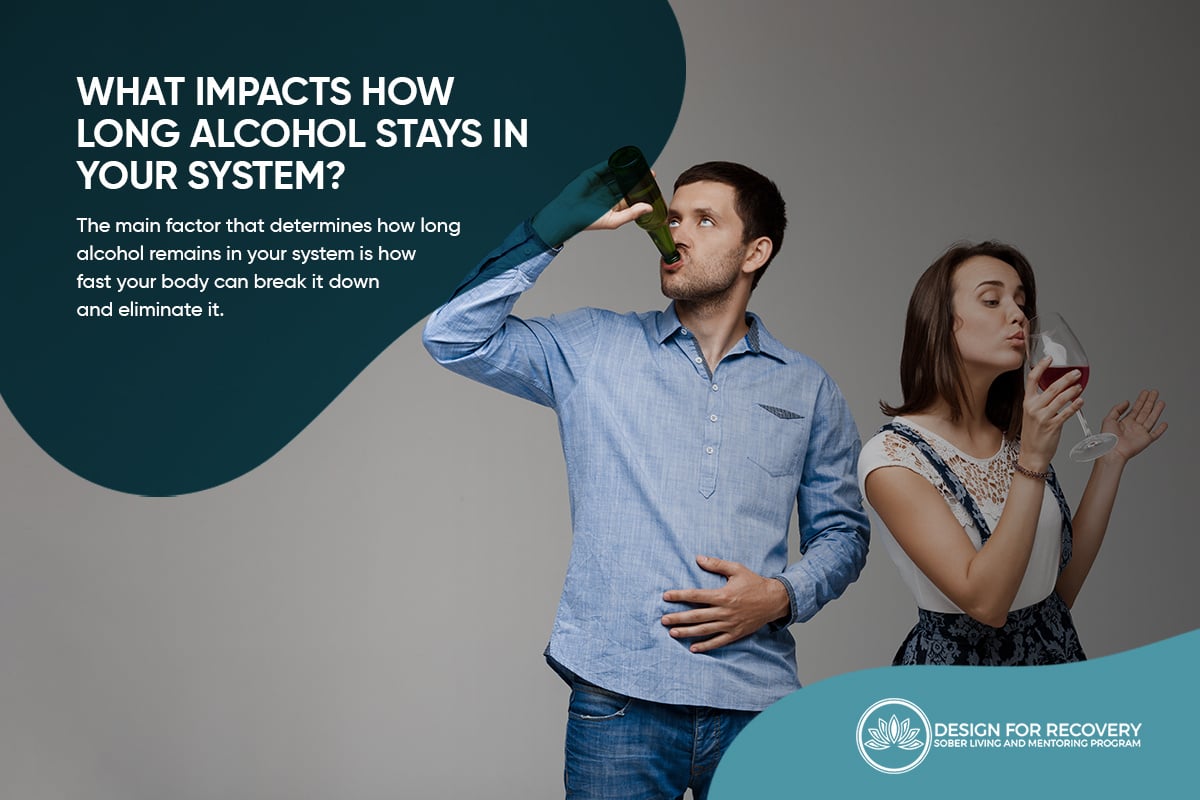
Biological Sex
Did you know that men and women handle alcohol differently?
Due to physiological reasons, women absorb alcohol differently from men. Because biologically, females tend to have a higher percentage of body fat and a lower percentage of body water compared to men, they tend to achieve higher blood alcohol concentration when they drink the same amount of alcohol as men, even when accounting for differences in size.
At the same time, women seem to get rid of alcohol from their blood faster than men. This could be because women have more liver per body mass than men, and the liver is where alcohol is broken down.
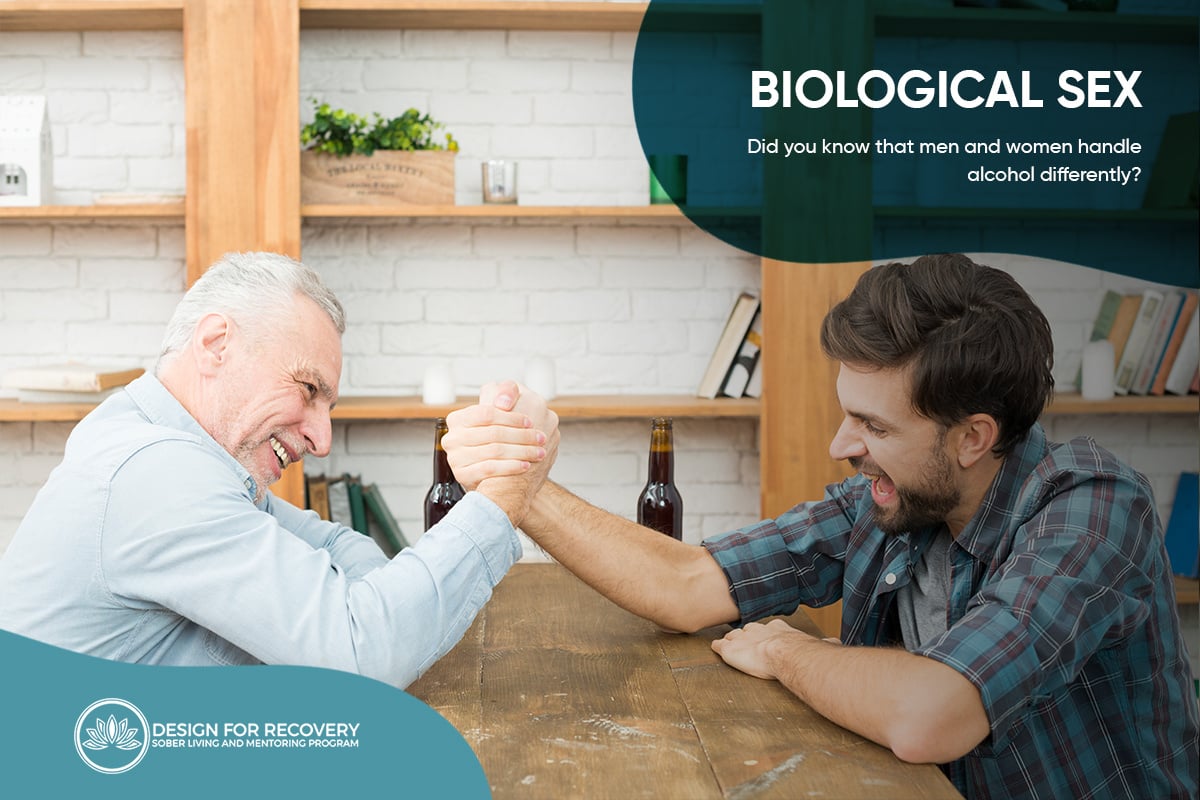
Call Design for Recovery to Begin Your Healing Journey!
Reach out to our team to discuss sober living options and next steps toward a healthier routine.
Age
Age and alcohol are a risky combination. As people get older, their liver function and enzyme activity decline, which means they metabolize alcohol slower and have higher BACs for the same amount of alcohol ingested.
In simple terms, the older you are, the longer alcohol stays in your body. It also makes you more susceptible to liver disease.

Weight
A person’s body weight and type also affect how they absorb alcohol. The more you weigh, the more body water there is in your body for the alcohol to spread out.
That means the alcohol gets diluted and has less impact on you. But if you weigh less, the alcohol has less space to go and stays more concentrated in your blood. That means you feel the effects of alcohol more strongly and faster. So be careful when you drink, especially if you’re on the lighter side!

Food Intake
Eating before or while drinking slows down the absorption of alcohol into the bloodstream, which lowers the peak BAC and reduces the effects of alcohol. If you drink on an empty stomach, the alcohol goes into your blood faster and raises the peak BAC, which increases the effects of alcohol.
Conversely, if you eat before or while drinking, the alcohol goes into your blood slower and makes you feel less drunk.
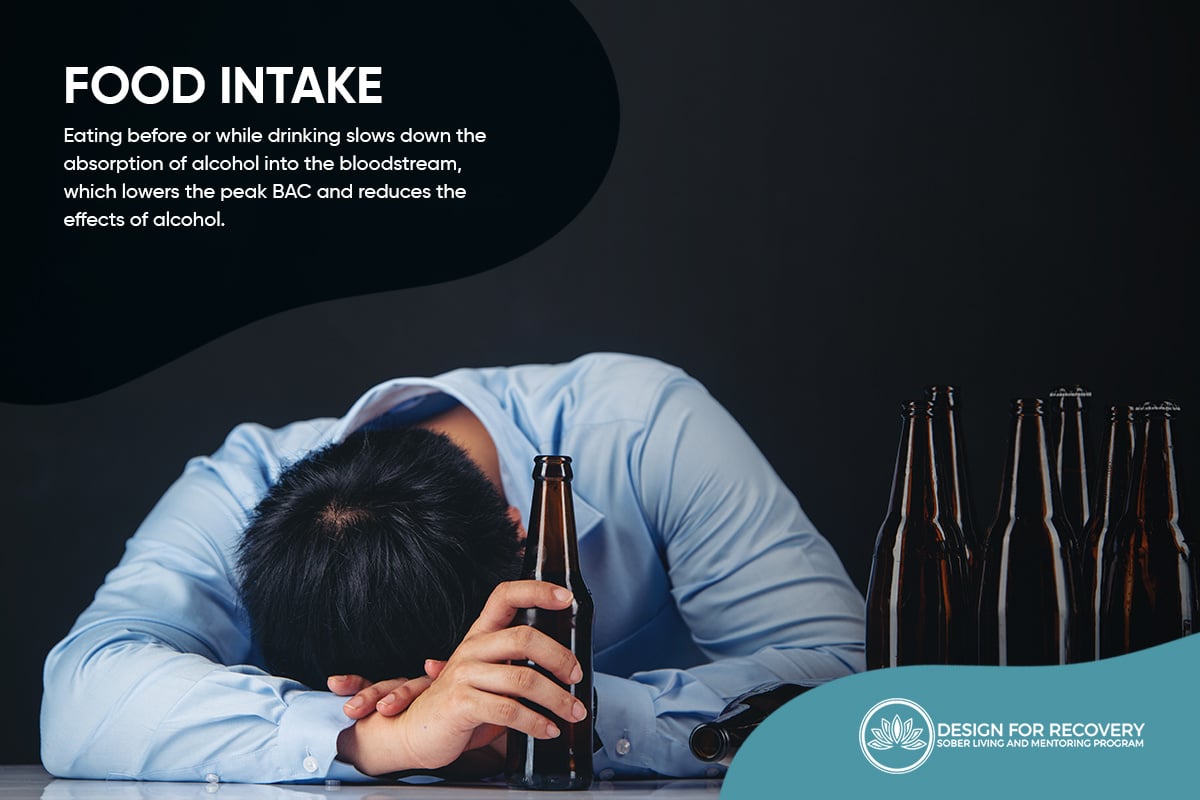
Drinking Habits
The amount of alcohol consumed and the frequency of consumption also play a significant role in how long it stays in your system. If a person drinks a lot or gets drunk often, it can accumulate alcohol byproducts in the body, resulting in a longer detection window.
The amount of alcohol consumed and the frequency of consumption also play a significant role in how long it stays in your system. If a person drinks a lot or gets drunk often, it can accumulate alcohol byproducts in the body, resulting in a longer detection window.
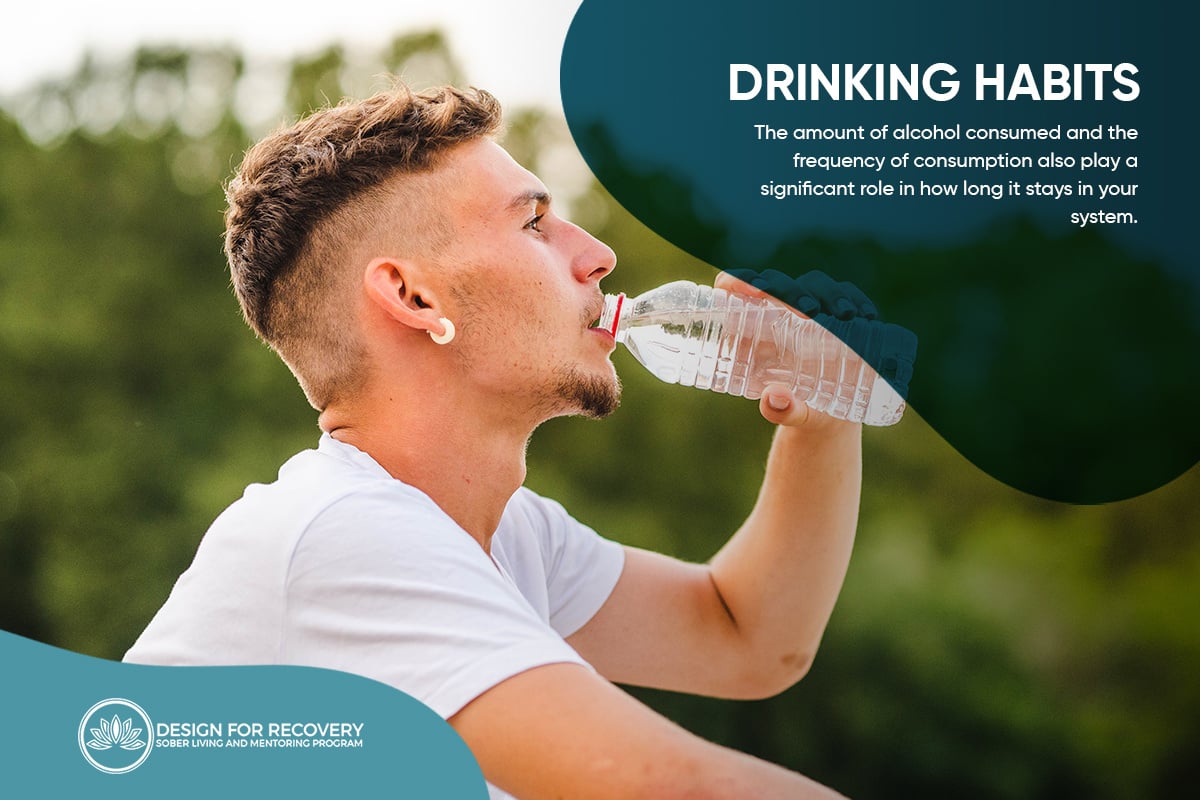
Hydration and Kidney Function
Just as your food intake affects how your body processes alcohol, so does hydration. If you don’t drink enough water, your kidneys will have a harder time doing their job, and alcohol will stay in your system longer.
Conversely, drinking enough water can help your body get rid of alcohol faster. Water helps your kidneys work better, so they can pee out the alcohol and other stuff that comes with it.
Keep in mind that water does not directly flush out alcohol. It only helps after the liver has metabolized it all. The effect of water intake on alcohol processing depends on how long and how much alcohol has been in the body and bloodstream. Drinking water will not have any effect on your blood alcohol levels.
It is recommended to drink eight cups of water a day, but if you’ve been taking alcoholic drinks, you should still try to have more than that if possible.
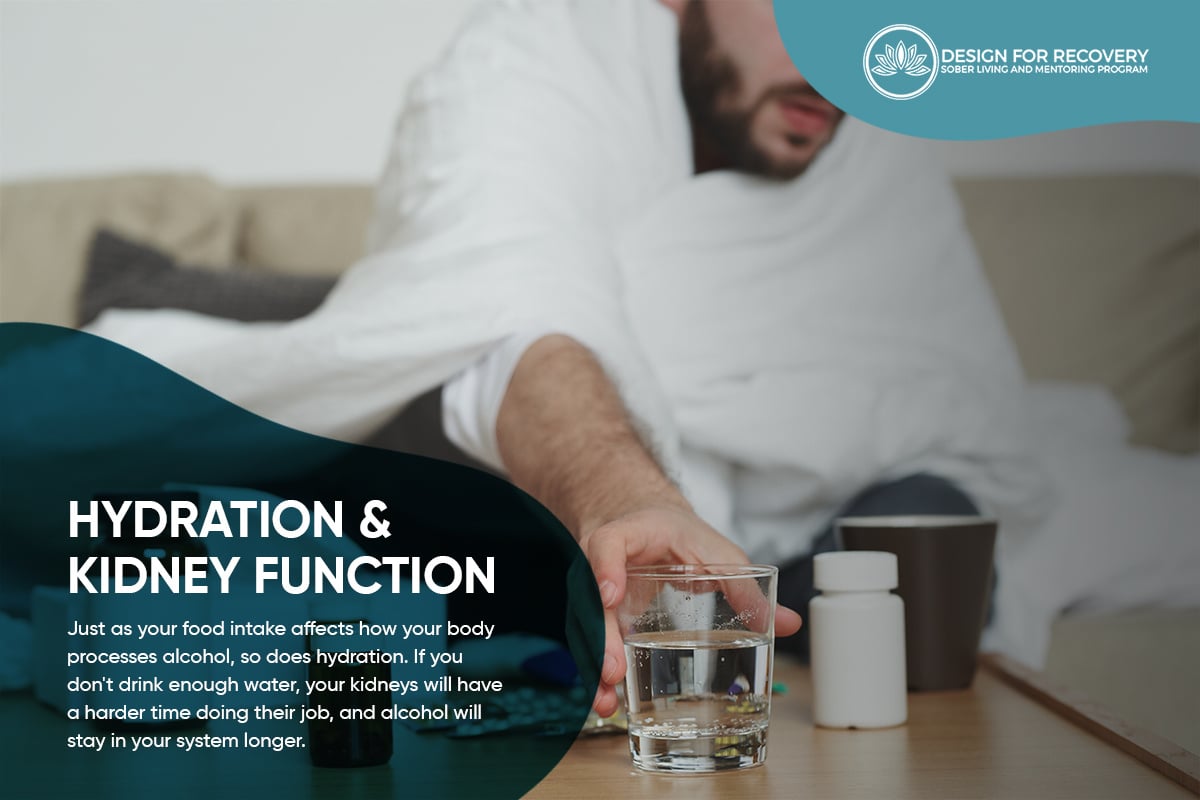
Medication
Some medicines can make it harder or easier for your body to break down alcohol. This can make you feel more drunk or hungover than usual. For example, some drugs for infections, allergies, pain, depression, and other behavioral health conditions can make a harmful chemical called acetaldehyde build up in your body and cause more headaches, nausea, and vomiting.
If a person mixes alcohol with certain medications, it can also lead to adverse effects. Plus, some health problems can change how your body handles alcohol and how fast you get rid of it. It’s very important to talk to your doctor or other qualified healthcare providers about potential interactions between alcohol, medications, and underlying health conditions.
Genetics
Genetics plays a significant role in how our bodies metabolize alcohol. Certain genetic variations can impact the activity of enzymes involved in breaking down alcohol, affecting how quickly or slowly alcohol is processed and eliminated from the body.
For example, some people of Asian descent have a mutation that makes their ALDH less effective at breaking down acetaldehyde, which causes them to flush red and feel sick when they drink alcohol.
The genetic variations in alcohol-metabolizing enzymes are relatively common and can differ among populations. However, it is worth noting that while genetics can influence how alcohol is metabolized, they do not determine a person’s risk of developing alcohol addiction or alcohol-related health issues. Environmental factors and individual drinking patterns also play significant roles.
Remember that individual responses to alcohol can vary, and these factors provide general guidance rather than definitive timelines. If you have concerns about alcohol consumption or its effects on your body, it’s always advisable to seek guidance from healthcare professionals or addiction specialists who can provide personalized advice.
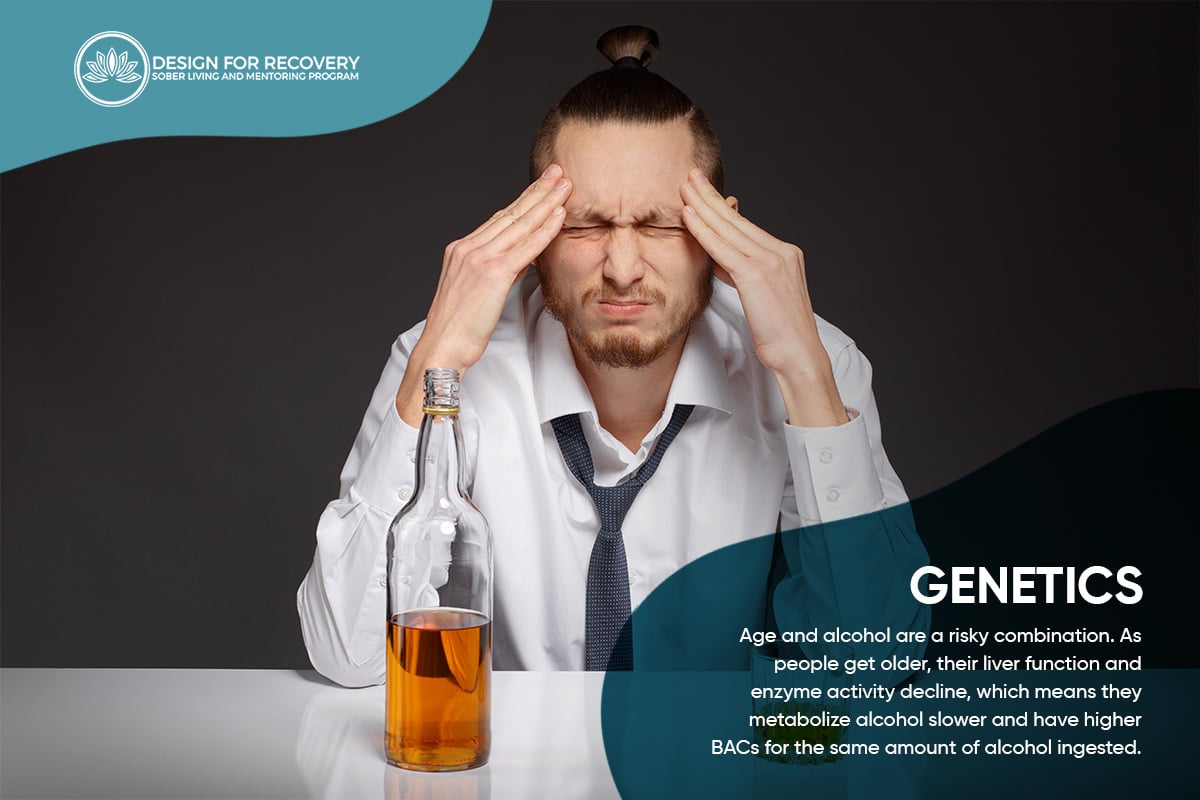
Contact Design for Recovery Today!
Fill out our quick form to connect with a peer mentor and learn how our sober living community supports accountability, structure, and personal growth in recovery.
How Long Does it Take to Feel the Effects of Alcohol?
The time it takes to feel the effects of alcohol can vary from person to person. On average, it takes about 30 minutes to one hour for the effects of alcohol to kick in after consumption. However, this can vary depending on factors such as the individual’s body weight, metabolism, tolerance, and the amount of alcohol consumed.
The effects of alcohol depend on your BAC and how it affects your central nervous system (CNS), which controls your brain and other organs. Alcohol is a CNS depressant, which means it reduces stimulation in your CNS and affects every organ in your body.

The effects of alcohol can start to be felt within 10 minutes of drinking, but it can take up to an hour for the full effects to kick in. The effects can last for several hours, depending on how much you drank and how fast your body eliminates alcohol.
The only way to lower your BAC is to wait for your liver to metabolize the alcohol. Drinking water, coffee, or other beverages won’t speed up this process.
When Does It Become Alcoholism?
Alcoholism, also known as alcohol use disorder (AUD), is a chronic mental health disorder involving a physical and psychological dependence on alcohol.
People with AUD have difficulty controlling their drinking, even when it causes harm to themselves or others. It is a serious condition that can have detrimental effects on physical and mental health, relationships, and overall well-being. They may also experience withdrawal symptoms, such as tremors, anxiety, nausea, or seizures when they stop drinking.
Some of the common signs of alcoholism include:
- Drinking more or longer than intended.
- Having a strong urge or craving to drink.
- Failing to fulfill obligations at work, school, or home obligations due to drinking.
- Continuing to drink despite negative consequences, such as health problems, legal issues, or relationship troubles.
- Giving up or reducing activities that are important or enjoyable because of drinking.
- Drinking alone or in secret
- Drinking to cope with stress or emotions
- Developing a tolerance to alcohol means needing more to feel the same effects.
- Experiencing cravings or withdrawal symptoms when not drinking or drinking to avoid them.
- Failed attempts to cut down or control drinking
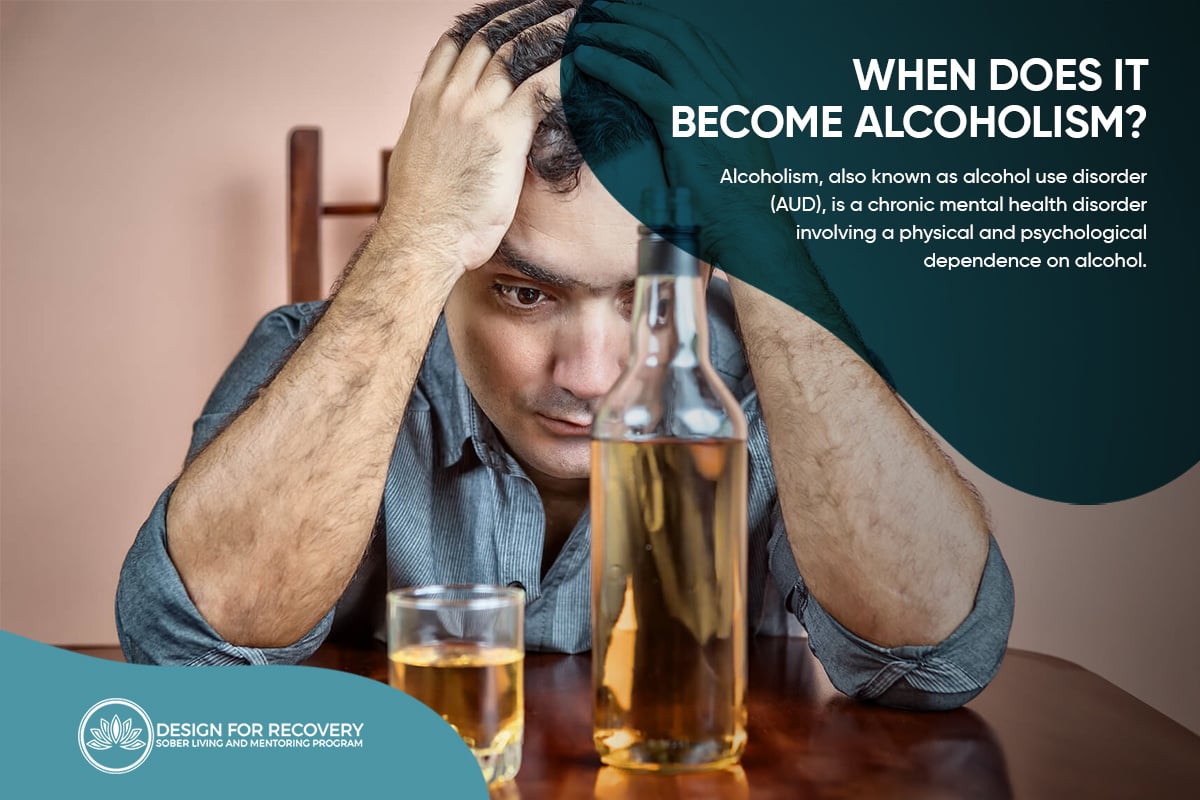
Risks of Alcohol Abuse
Alcohol is a widely used substance that can have harmful effects on your health and well-being. Alcohol abuse is a pattern of drinking that causes problems in your personal, professional, or social life. It can also lead to physical and mental disorders, injuries, and even death.
According to the World Health Organization (WHO), excessive alcohol consumption or substance abuse is a causal factor in more than 200 diseases and injury conditions. Some of the health risks of alcohol abuse include:
- Mental and behavioral disorders, such as depression, anxiety, alcohol dependence, and suicide
- Liver cirrhosis, hepatitis, and liver cancer
- Cardiovascular diseases, such as high blood pressure, stroke, and heart failure
- Digestive diseases, such as gastritis, pancreatitis, and esophageal cancer
- Cancers of the mouth, throat, breast, colon, and other organs
- Infectious diseases, such as tuberculosis and HIV/AIDS
- Fetal alcohol syndrome (FAS) and pre-term birth complications in pregnant women
- Unintentional and intentional injuries, such as road traffic crashes, violence, and homicide
Alcohol abuse can also affect your social and economic well-being. It can impair your judgment, decision-making, and memory and may cause conflicts with your family, friends, co-workers, and strangers. It can reduce your productivity and performance at work or school. A person who drinks too much may also experience increased healthcare costs and legal problems.
Alcohol Treatment Medications
Embarking on the journey to quit alcohol can be challenging, but with the right medical treatment, you can find the support you need to make lasting changes. Medical interventions can play a crucial role in managing alcohol withdrawal symptoms and promoting a safe and successful recovery.
There are several factors that affect how your body reacts to quitting alcohol. These include:
- Drinking habits, such as how much and how often you drink
- How long you have been drinking
- Your age, gender, weight, and genetics
- Medical history and current health conditions
- If you use other substances or medications
Depending on these factors, you may experience mild to severe withdrawal symptoms when you quit drinking. These may include:
- Anxiety, irritability, mood swings
- Insomnia, nightmares
- Tremors, sweating
- Nausea, vomiting
- Headache
- Increased heart rate and blood pressure
- Seizures
- Hallucinations
- Delirium tremens (DTs)
This is where medication may come in. Your doctor may prescribe you one or more medications to help you manage these symptoms and reduce the risk of complications.
Some of the common medications used for alcohol treatment are:
Benzodiazepines
These are sedatives that can help you calm down and relax. Benzodiazepines help alleviate withdrawal symptoms such as anxiety, insomnia, and seizures. They can also prevent seizures and DTs. Examples are diazepam (Valium), lorazepam (Ativan), chlordiazepoxide (Librium), and oxazepam (Serax).
- Pros: They are effective and fast-acting.
- Cons: They can be addictive and cause drowsiness, confusion, and memory problems. They can also interact with other drugs or alcohol.
Anticonvulsants
Anticonvulsants are drugs that can prevent or treat seizures. Examples are carbamazepine (Tegretol), valproate (Depakote), gabapentin (Neurontin), and topiramate (Topamax).
Pros: Anticonvulsants are often less addictive than benzodiazepines. They can also treat other conditions like bipolar disorder, migraine headaches, or neuropathic pain.
- Cons: They can cause side effects such as dizziness, fatigue, weight gain or loss, nausea, and rash. Similar to benzodiazepines, they can also interact with other drugs or alcohol.
Naltrexone
Unlike benzodiazepines and anticonvulsants, which are only used for managing alcohol withdrawal symptoms, naltrexone is a drug approved by the Food and Drug Administration specifically for the treatment of substance use disorders, specifically alcohol addiction and opioid addiction.
Naltrexone works by binding to the endorphin receptors in the body. It helps block the effects and pleasant feelings associated with alcohol. By doing so, naltrexone can reduce the cravings for alcohol and the amount of alcohol a person consumes.
Naltrexone works by binding to the endorphin receptors in the body. It helps block the effects and pleasant feelings associated with alcohol. By doing so, naltrexone can reduce the cravings for alcohol and the amount of alcohol a person consumes.
It can also reduce the craving for alcohol by interfering with the reward system. It comes in oral form (Revia) or injectable form (Vivitrol).
- Pros: It can help you stay abstinent from alcohol by reducing the desire to drink and how much alcohol you consume. It can also treat opioid addiction.
- Cons: It can cause side effects such as nausea, headache, drowsiness, and injection site reactions. It can also precipitate withdrawal symptoms if you use opioids while taking them.
Acamprosate
Another FDA-approved drug for substance use disorder, acamprosate restores the balance of chemicals in the brain that is disrupted by chronic alcohol use. It can help you maintain sobriety by reducing the physical and emotional distress associated with quitting alcohol. It comes in oral form (Campral).
- Pros: Helps you cope with post-acute withdrawal syndrome (PAWS) that may last for months or years after quitting alcohol. It has no abuse potential and does not interact with other drugs or alcohol.
- Cons: It can cause side effects such as diarrhea, nausea, headache, and insomnia. It may not be effective for everyone.
Disulfiram
Disulfiram is another commonly used drug for alcohol treatment. It works as a deterrent against further drinking by inhibiting the enzyme that breaks down alcohol in the body. This leads to unpleasant reactions when you drink alcohol, such as flushing, nausea, vomiting, headache, and palpitations.
It comes in oral form (Antabuse).
- Pros: It can deter you from drinking alcohol by creating a negative association. It can also increase your motivation and commitment to quit drinking.
- Cons: It may cause severe reactions if you drink even a small amount of alcohol. It can also cause side effects such as drowsiness, fatigue, skin rash, and liver problems. It can also interact with other drugs or alcohol.
Keep in mind that these medications are not a cure for alcohol addiction. They are only meant to assist you in your recovery process. It is important to consult your doctor before taking any medication and carefully follow their instructions. Additionally, combining medication with other forms of treatment like counseling, therapy, support groups, and lifestyle changes can contribute to a long-lasting recovery.
Find Support for Alcohol Addiction in Design for Recovery
If you or someone you know is struggling with alcohol addiction, it’s crucial to seek support and professional help. Design for Recovery is a structured sober living home for men in Los Angeles, California.
Our program is designed to help men recovering from substance use disorders. Design for Recovery offers a range of programs and resources designed to assist individuals on their journey to recovery.
Our team of dedicated professionals provides personalized treatment plans tailored to each individual’s needs, ensuring that they receive the necessary support and guidance throughout their recovery process.
By choosing Design for Recovery, you can access various services designed to address the physical, emotional, and psychological aspects of alcohol addiction, helping individuals overcome their dependence on alcohol and build healthier, sober life.
Additionally, Design for Recovery fosters a supportive community environment where individuals can connect with peers who understand their struggles and offer encouragement and empathy. This sense of community plays a crucial role in the recovery journey, providing a network of support and understanding.
Remember, seeking help is a courageous step towards a healthier and happier life. Don’t hesitate to reach out to Design for Recovery to start your journey toward recovery from alcohol addiction.
- What is a Standard Drink?
- How is Alcohol Metabolized in the Body?
- How Long Does Alcohol Stay in the Body?
- How is Alcohol Measured in Your Body?
- What Impacts How Long Alcohol Stays in Your System?
- Biological Sex
- Age
- Weight
- Food Intake
- Drinking Habits
- Hydration and Kidney Function
- Medication
- Genetics
- How Long Does it Take to Feel the Effects of Alcohol?
- When Does It Become Alcoholism?
- Risks of Alcohol Abuse
- Alcohol Treatment Medications
- Benzodiazepines
- Anticonvulsants
- Naltrexone
- Acamprosate
- Disulfiram
- Find Support for Alcohol Addiction in Design for Recovery
Begin Lasting Sobriety Now!
Frequently Asked Questions
Alcohol is typically eliminated from your system within a few hours to a few days, depending on factors such as metabolism and the amount consumed. However, it’s important to note that the effects of alcohol on your body and mind may last longer.
Whether you pass or fail alcohol testing depends on the type of test and how much you drank. If you take a blood or saliva test, you may be able to pass it if you only had one or two drinks and waited at least 12 hours before taking the test. However, if you take a urine or hair test, you may not be able to pass it even if you only had one drink and waited 24 hours.
That said, it’s always best to avoid drinking if you need to pass an alcohol test. The safest approach is to allow ample time for your body to metabolize and eliminate the alcohol.
The only way to remove alcohol from your body is to let your liver metabolize it naturally. This process takes time and cannot be sped up by any means. Drinking water, eating food, and getting enough rest can support the body’s natural detoxification process. However, this will not guarantee getting rid of alcohol faster. The best way to avoid having alcohol in your system is to drink moderately or not at all.
Drinking water does not help with alcohol tests. The only way to reduce the amount of alcohol in your system is to wait for it to be metabolized by your liver. The best course of action is to refrain from drinking alcoholic beverages if you need to pass a test.
Besides consuming alcoholic beverages, certain medications, foods, and products can contain small amounts of alcohol that may appear on urine tests. For example, some cough syrups, mouthwashes, breath sprays, hand sanitizers, baked goods, vanilla extract, vinegar, and fermented foods can potentially result in a positive alcohol test.
It’s important to disclose any substances you have consumed or medications you are taking to the testing authority to avoid potential misunderstandings. If you are taking urine alcohol tests, we suggest avoiding these items for at least 24 hours before the test.
The detection period for alcohol in a probation drug test can vary depending on the type of test being conducted. Probation drug tests usually use urine or hair samples to detect alcohol use.
In general, alcohol can be detected in urine for up to 12 to 48 hours after consumption, while hair tests can detect alcohol for up to 90 days after drinking. The exact time frame depends on how much and how often you drink and other factors such as a person’s body size, age, biological sex, metabolism, and more.
It’s best to consult with your probation officer or legal representative to understand the specific requirements and guidelines for alcohol testing during probation.
A breathalyzer is a device that measures the amount of alcohol in your breath, which reflects the amount of alcohol in your blood. The more you drink, the higher your BAC will be and the longer it will take for it to drop below the legal limit of 0.08%. On average, it takes about one hour for your BAC to decrease by 0.015%. This means that if you have a BAC of 0.08%, it will take about 5 hours for it to reach zero.
A breathalyzer test can detect alcohol in your breath for up to 24 hours after consumption, depending on various factors. The best approach is to refrain from drinking alcohol before operating a vehicle or if you need to pass a breathalyzer test.
Alcohol can impair your driving ability even hours after consumption. It’s always safest to wait until you are sober before getting behind the wheel. Laws and regulations regarding alcohol and driving may vary by jurisdiction, so it’s important to be aware of the legal limits and guidelines in your area.
The legal limit for driving is 0.08% BAC in most states, but some states have lower limits or zero-tolerance laws for certain drivers.
You should never drive if you feel impaired by alcohol or any other substance. The safest way to avoid driving under the influence is to plan ahead and arrange a sober ride home.
Alcohol can pass into breast milk and affect your baby’s development and health. The amount of alcohol in breast milk is similar to the amount of alcohol in your blood. It takes about one to two hours for one standard drink (12 ounces of beer, 5 ounces of wine, or 1.5 ounces of liquor) to leave your system.
It is recommended that you avoid drinking alcohol while breastfeeding. If you choose to drink, you should limit your intake to one drink per day and wait at least two hours before nursing or pumping.
Disclaimer: The information provided here is for educational purposes only and should not replace professional medical advice. If you have concerns about alcohol use, addiction, or treatment options, it’s best to consult a qualified healthcare professional or reach out to addiction specialists for guidance.
We hope this blog has provided you with valuable insights into how long alcohol stays in the body and its potential effects. If you or someone you know is struggling with alcohol abuse, don’t hesitate to seek help. Recovery is possible, and resources are available to support you on your journey to a healthier and happier life.
- Ayuso, P., García-Martín, E., Cornejo-García, J. A., G. Agúndez, J. A., & Ladero, J. M. (2021). Genetic Variants of Alcohol Metabolizing Enzymes and Alcohol-Related Liver Cirrhosis Risk. Journal of Personalized Medicine, 11(5). https://doi.org/10.3390/jpm11050409
- Bonnet, U., Schäfer, M., Richter, C., Milkereit, J., Wiltfang, J., Scherbaum, N., & Lieb, B. (2009). Antikonvulsiva in der Behandlung der Alkoholabhängigkeit [Anticonvulsants in the treatment of alcoholism]. Fortschritte der Neurologie-Psychiatrie, 77(4), 192–202. https://doi.org/10.1055/s-0028-1109214
- https://www.cdc.gov/alcohol/excessive-drinking-data/
- Frezza, M., di Padova, C., Pozzato, G., Terpin, M., Baraona, E., & Lieber, C. S. (1990). High blood alcohol levels in women. The role of decreased gastric alcohol dehydrogenase activity and first-pass metabolism. The New England journal of medicine, 322(2), 95–99. https://doi.org/10.1056/NEJM199001113220205
- McDonell, M. G., Skalisky, J., Leickly, E., McPherson, S., Battalio, S., Nepom, J. R., Srebnik, D., Roll, J., & Ries, R. K. (2015). Using Ethyl Glucuronide in Urine to Detect Light and Heavy Drinking in Alcohol Dependent Outpatients. Drug and alcohol dependence, 157, 184. https://doi.org/10.1016/j.drugalcdep.2015.10.004
- Meier, P., & Seitz, H. K. (2008). Age, alcohol metabolism and liver disease. Current opinion in clinical nutrition and metabolic care, 11(1), 21–26. https://doi.org/10.1097/MCO.0b013e3282f30564
- Naltrexone. SAMHSA. (n.d.). https://www.samhsa.gov/medications-substance-use-disorders/medications-counseling-related-conditions/naltrexone
- Paton, A. (2005). ABC of alcohol: Alcohol in the body. BMJ : British Medical Journal, 330(7482), 85-87. https://doi.org/10.1136/bmj.330.7482.85
- Sachdeva, A., Choudhary, M., & Chandra, M. (2015). Alcohol Withdrawal Syndrome: Benzodiazepines and Beyond. Journal of Clinical and Diagnostic Research : JCDR, 9(9), VE01. https://doi.org/10.7860/JCDR/2015/13407.6538
- Understanding Alcohol’s Effects. Stanford Medicine Children’s Health – Lucile Packard Children’s Hospital Stanford. (n.d.). https://www.stanfordchildrens.org/en/topic/default?id=understanding-alcohols-effects-1-2860
- U.S. Department of Health and Human Services. (2000, October). Are women more vulnerable to alcohol’s effects?-alcohol alert no. 46-1999. National Institute on Alcohol Abuse and Alcoholism. https://pubs.niaaa.nih.gov/publications/aa46.htm#:~:text=Women%20absorb %20and%20metabolize%20alcohol,alcohol%20(5%2C6).
- U.S. Department of Health and Human Services. (n.d.). What is a standard drink?. National Institute on Alcohol Abuse and Alcoholism. https://www.niaaa.nih.gov/alcohols-effects-health/overview-alcohol-consumption/what-standard-drink#:~:text=In%20the%20United%20States %2C%20one,is%20usually%20about%205%25%20alcohol
- Wall, T. L., & Ehlers, C. L. (1995). Genetic Influences Affecting Alcohol Use Among Asians. Alcohol Health and Research World, 19(3), 184-189. https://www.ncbi.nlm.nih.gov/pmc/articles/PMC6875758/
- World Health Organization. (n.d.). Alcohol. World Health Organization. https://www.who.int/news-room/fact-sheets/detail/alcohol




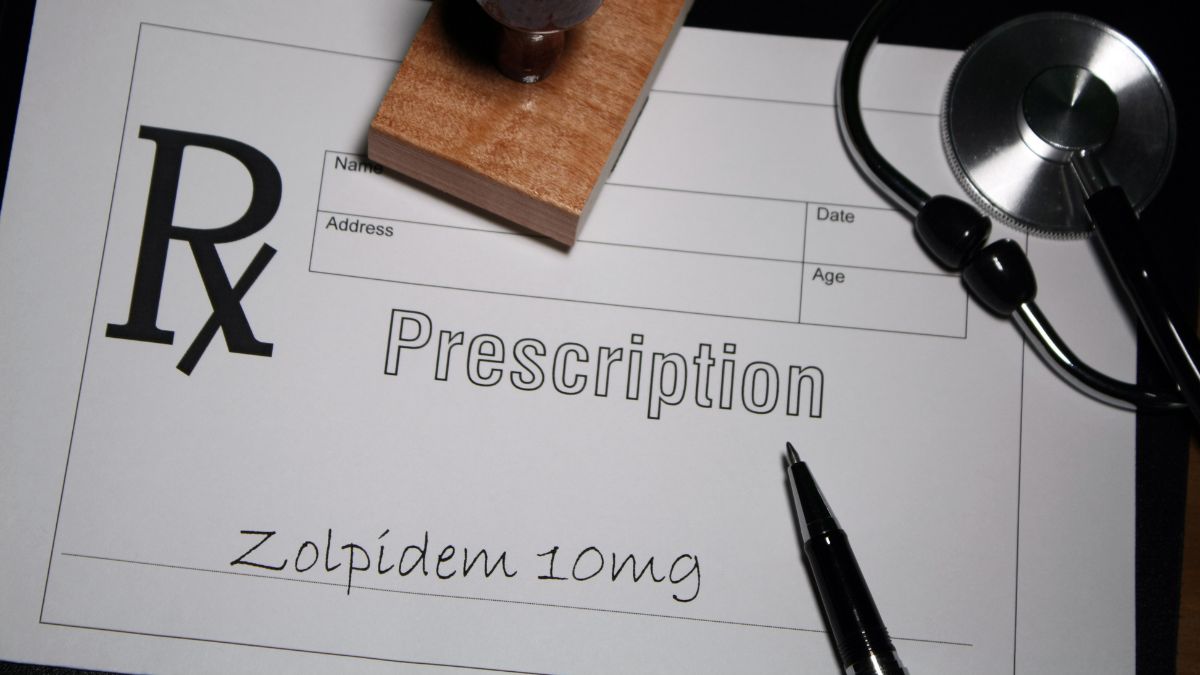

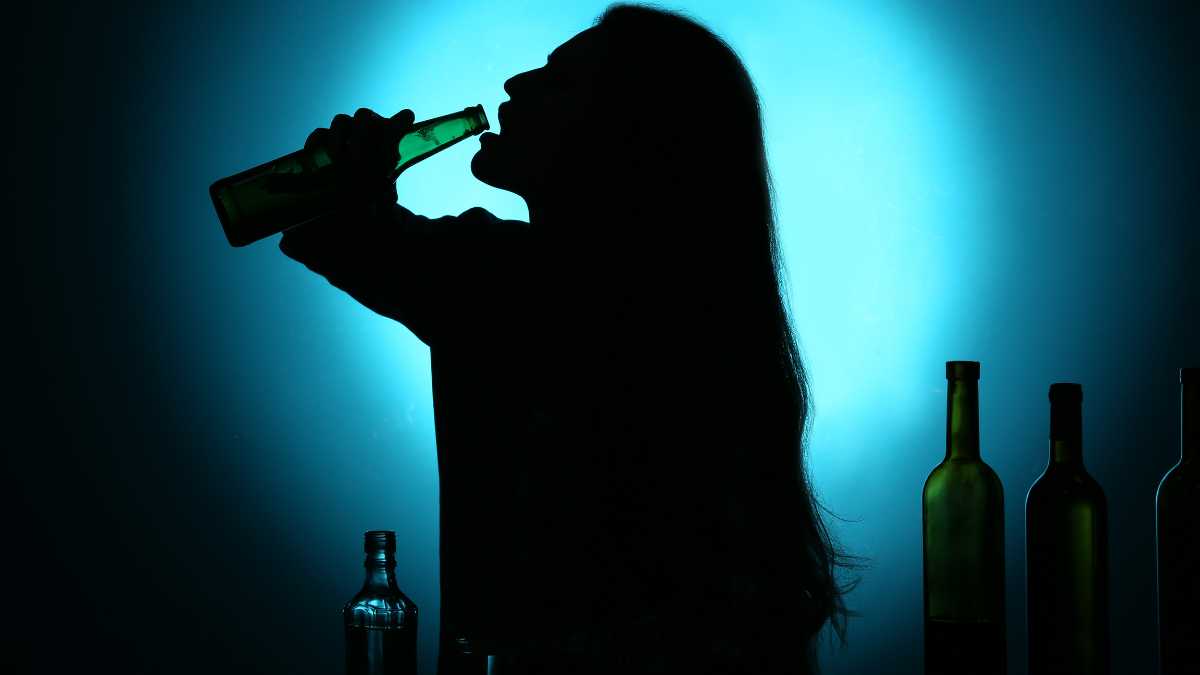
Written By
David Beasley